Voodoo and Ghosts in New Orleans

New Orleans, a city draped in veils of mystery and magic, is renowned for its deep connections with Voodoo and ghosts.
Why Albino Alligators are so Special?

The Enigmatic World of Albino Alligators Albino alligators are among the most intriguing and rarest wildlife spectacles in the world. With their striking white skin and distinct pinkish eyes, these creatures offer a glimpse into the marvels of nature’s diversity. But why are albino alligators so special, and where can one encounter these extraordinary animals? The Science Behind the Rarity Albinism in alligators is a result of a genetic anomaly that affects melanin production, the pigment responsible for coloring their skin and scales. This condition not only makes them exceedingly rare but also highly sensitive to sunlight. Unlike their darker counterparts, albino alligators have reduced chances of survival in the wild due to their lack of camouflage and heightened vulnerability to predators and harsh environmental conditions. Albinism and Its Challenges The rarity of albino alligators makes them a phenomenon that requires special attention. These alligators often need protective care to survive, which is why they are predominantly found in controlled environments like zoos or specialized wildlife reserves. Their care includes health monitoring, controlled exposure to sunlight, and tailored diets to support their unique needs. Habitat and Conservation Efforts In captivity, albino alligators serve as ambassadors for genetic diversity and conservation education. Facilities across the southern United States, particularly in Louisiana, have taken up the mantle to protect and study these rare creatures. These programs aim not only to ensure the survival of albino alligators but also to educate the public on the importance of biodiversity and conservation. Where to See Albino Alligators New Orleans and the wider Louisiana area host several facilities where the public can view albino alligators. These include renowned zoos and wildlife sanctuaries that focus on the conservation of rare species. Visiting these locations offers a unique opportunity to learn about the challenges of wildlife conservation and the specific needs of rare animals like albino alligators. Cultural Significance and Public Fascination The albino alligator holds a special place in the cultural landscape of New Orleans. Often regarded as a symbol of the unique and mysterious, their rare appearance and striking features captivate locals and tourists alike. Their presence in New Orleans also adds to the city’s allure, combining nature’s anomalies with rich cultural heritage. Interactive and Educational Experiences Educational programs and interactive tours dedicated to albino alligators provide visitors with in-depth knowledge about the biological and environmental aspects of albinism in reptiles. These programs highlight the importance of conservation efforts and the role of genetics in biodiversity. Why Albino Alligators Fascinate Us The rarity and striking appearance of albino alligators symbolize nature’s mysteries and the need to protect its diversity. They challenge our understanding of survival and adaptation, reminding us of the importance of protecting even the most vulnerable wildlife. A Call to Experience the Wonder Visiting a facility that cares for albino alligators is more than just an educational experience; it’s a chance to witness the beauty and resilience of one of nature’s most unusual creatures. Whether you’re a wildlife enthusiast, a curious traveler, or someone passionate about conservation, seeing an albino alligator is an unforgettable experience. Don’t miss the chance to encounter these rare animals on your next visit to New Orleans, where the wonder of nature meets the charm of the city.
Are There Crocodiles in Louisiana?
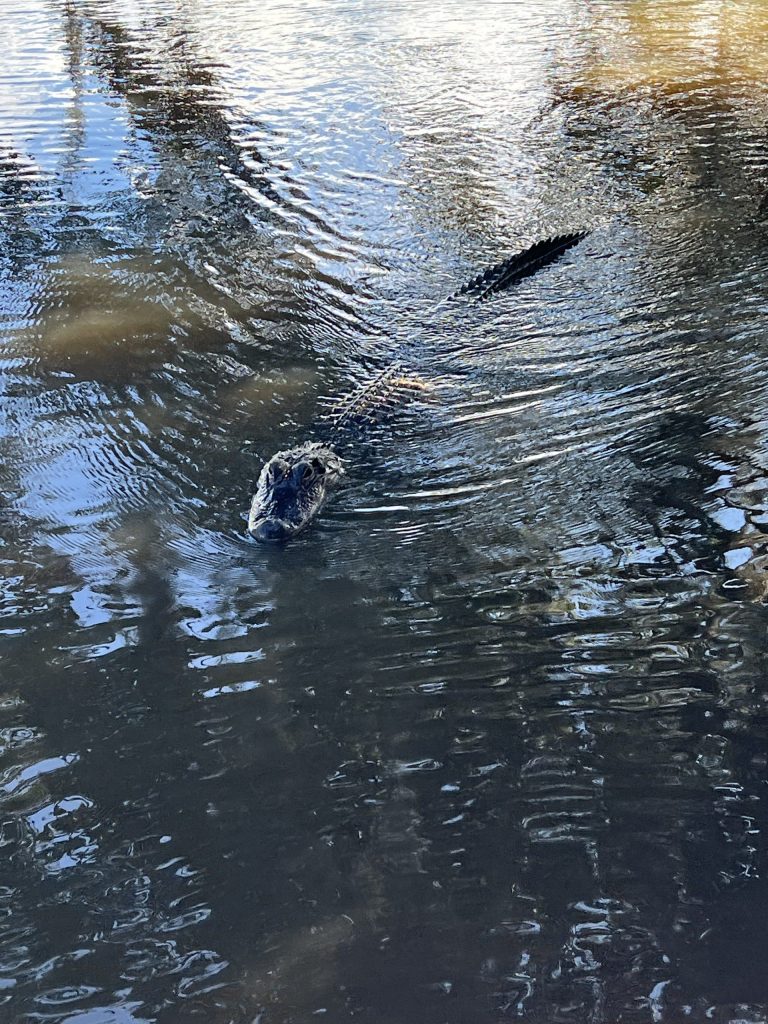
Are there crocodiles in Louisiana? Louisiana is a state known for its rich cultural heritage, vibrant music scene, and unique wildlife. The swamps and bayous of Louisiana are teeming with diverse flora and fauna, drawing nature enthusiasts from all over the world. Among the many creatures that inhabit these wetlands, alligators are a common sight. This article explores whether there are crocodiles in Louisiana and delves into the fascinating world of these ancient reptiles. Alligators vs. Crocodiles First, let’s clarify the difference between alligators and crocodiles. Alligators and crocodiles are both members of the reptile family, but they belong to different genera. Alligators have a wider, U-shaped snout, while crocodiles have a more pointed, V-shaped snout. Crocodiles are typically found in saltwater habitats, whereas alligators prefer freshwater environments. Feature Crocodile Alligator Snout Shape V-shaped, narrow U-shaped, wider Habitat Saltwater and freshwater Freshwater Skin Color Upper and lower teeth visible when closed Only upper teeth visible when closed Teeth Visibility Light olive brown/green Dark grey/black Alligators in Louisiana Louisiana is home to a large population of American alligators. These reptiles thrive in the state’s extensive wetlands. Alligators can be found in swamps, marshes, rivers, and lakes. They play a crucial role in the ecosystem by maintaining the balance of aquatic life. Crocodiles in Louisiana While Louisiana has a significant population of alligators, it does not have native crocodiles. The climate and habitat of Louisiana are more suitable for alligators. Crocodiles are primarily found in tropical and subtropical regions. The closest species of crocodile to Louisiana is the American crocodile, which resides in South Florida. Are there Crocodiles in Louisiana? The short answer is no. The absence of crocodiles in Louisiana can be attributed to several factors: 1. Climate: Crocodiles prefer warmer, tropical climates. Louisiana’s seasonal temperature variations are more suited to alligators. 2. Habitat: Alligators are well-adapted to the freshwater environments of Louisiana. Crocodiles, on the other hand, thrive in brackish or saltwater habitats. 3. Geographical Range: The natural range of the American crocodile does not extend to Louisiana. They are primarily found in South Florida and the Caribbean. Additionally, crocodiles and alligators have different tolerances for cold. Alligators can survive in colder climates by slowing their metabolism and entering a state of brumation during the winter. Crocodiles lack this adaptation and require consistently warm temperatures to survive. While Louisiana is famous for its alligator population, it does not have native crocodiles. The state’s climate, habitat, and geographical factors make it an ideal environment for alligators. When exploring Louisiana’s wetlands, you will likely encounter alligators, not crocodiles. For more information on Louisiana’s wildlife, check out our other articles on local fauna and conservation efforts, or book your swamp tour today.
Unveiling the Bayou: New Orleans Tour Guide
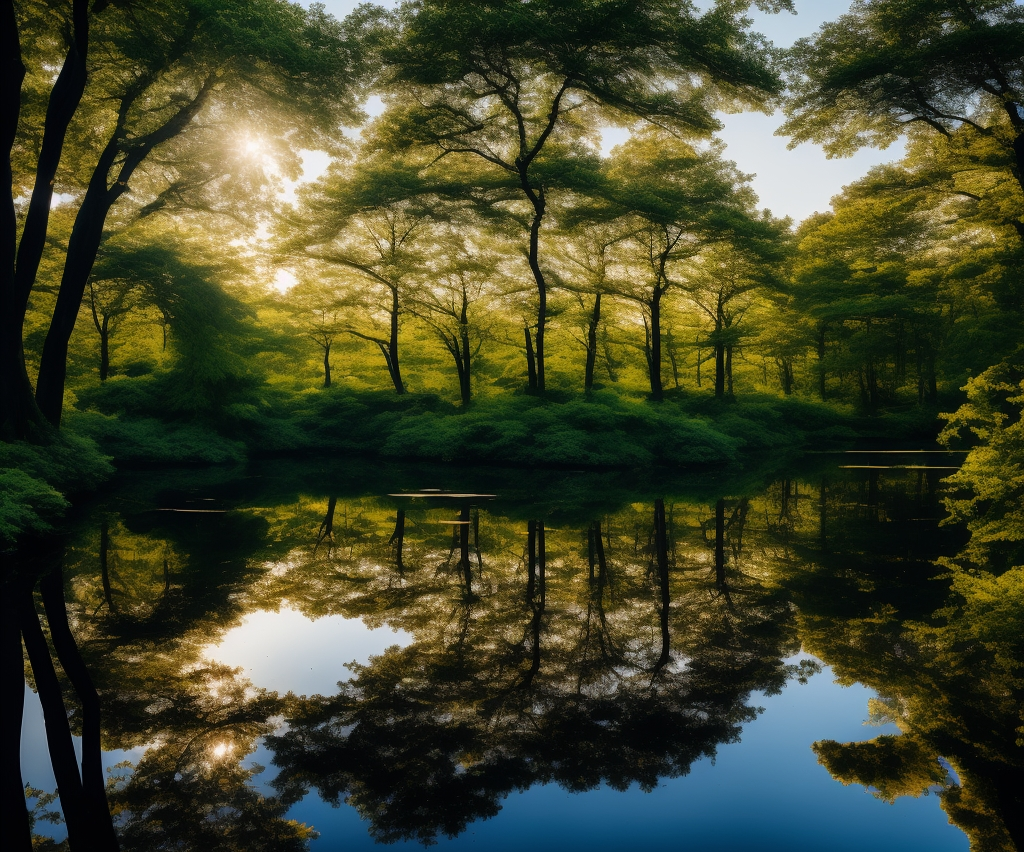
Exploring the Depths of New Orleans Bayou Tour There’s an old saying in New Orleans: “To know the heart of the city, one must navigate the veins of its bayous.” Stepping into a New Orleans bayou tour is akin to flipping open the pages of a living history book, interspersed with tales of nature, culture, and adventure. As we dive deeper into this magical world, you’ll soon understand why these wetland wonders are the crown jewels of the Big Easy. Nature’s Serenade: The Diversity of Bayou Tours Nature in the bayous is as harmonious as a jazz quartet. With each element playing its part, there’s always a new story waiting to be told. Next, we’ll discuss the vessels that sail these waters. Sail the Bayou: Picking the Perfect Vessel Choosing the right boat is crucial. It’s like selecting a genre of music – each provides a distinct flavor, rhythm, and experience. Now, on to a few tours that have garnered attention. Top-Rated Tours: Sailing Through Reviews and Recommendations With so many options, picking a tour might seem daunting. But, armed with reviews and a sense of adventure, the bayou awaits your presence. FAQ Like a jazz melody that lingers in your soul, the bayou leaves an indelible mark on every visitor. Ready for your next adventure?
What Is The Difference Between An Alligator and A Crocodile?
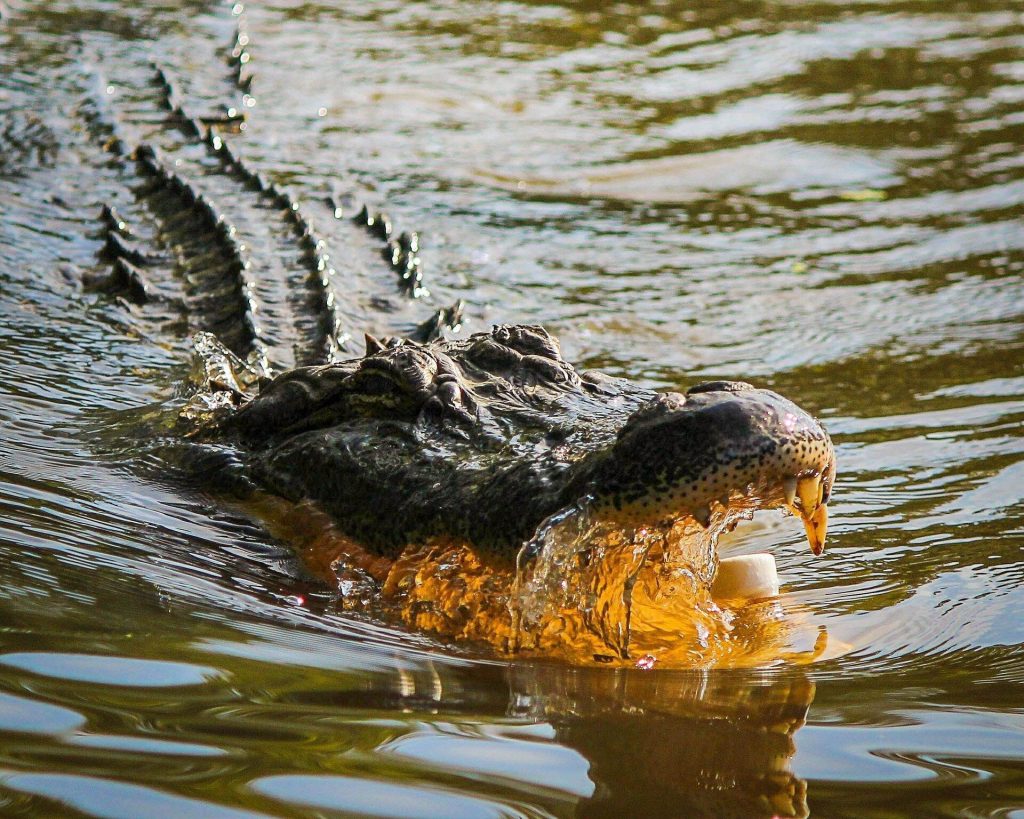
One place where you’re sure to find alligators is on a swamp tour through the Bayou in New Orleans. You don’t have to worry about alligators attacking you on your swamp tour since alligators are less aggressive than crocodiles and will typically escape if approached by humans.
When is King Cake Safe to Eat? A Survival Guide for Mardi Gras
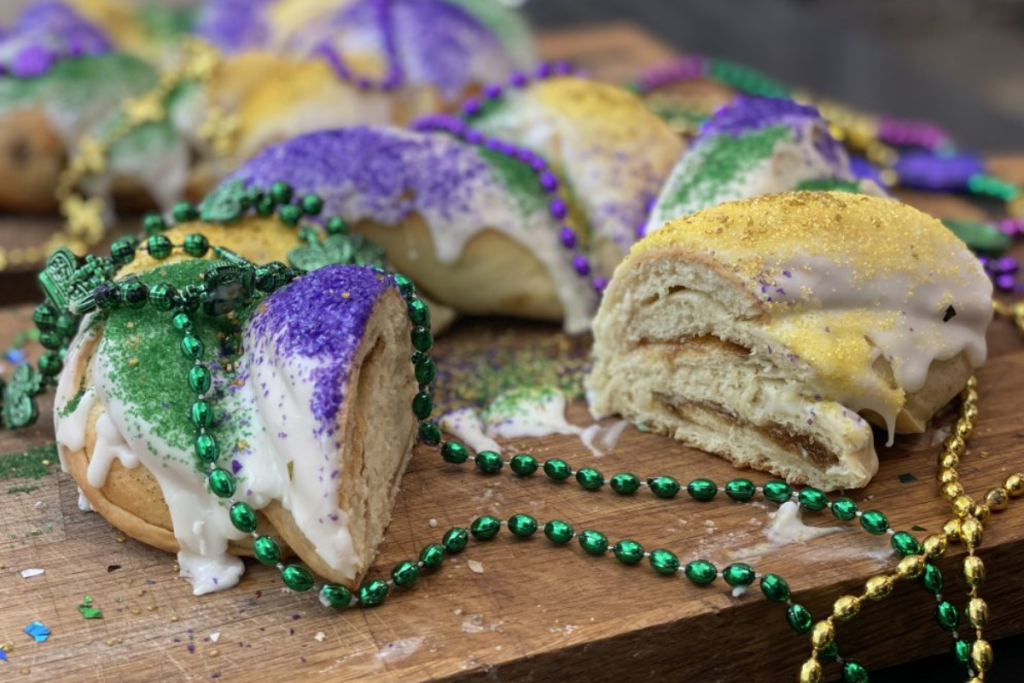
As Mardi Gras approaches, with its vibrant parades and festive spirit, one cannot help but think of the delicious King Cake, a staple of this jubilant season. This survival guide will delve into the rich history and traditions surrounding King Cake, as well as provide practical advice on how to safely enjoy it during the Mardi Gras celebrations. Whether you’re in New Orleans, Las Vegas, Greenville, or participating in local festivities, this guide will ensure you savor every bite of King Cake without worry. Key Takeaways Understanding the Tradition of King Cake The History of King Cake and Its Significance The King Cake is a vibrant part of Mardi Gras tradition, with its roots deeply embedded in ancient celebrations. Originally, the cake was associated with the festival of Epiphany, marking the arrival of the Three Wise Men or Kings, which is celebrated on January 6th. This rich history is reflected in the name itself, as the cake symbolizes the crowning of the newborn Christ by the Magi. In many cultures, the King Cake is adorned with colorful decorations, each color holding its own significance. The cake often conceals a small figurine, typically representing baby Jesus. Finding this hidden treasure is more than just a playful quest; it bestows a special honor upon the finder, who is then responsible for hosting the next celebration or becoming the ‘godparent’ of Jesus during the Candelaria. The tradition of King Cake is a delightful blend of religious symbolism and communal festivity, bringing people together to share in the joy and anticipation of finding the hidden surprise. While the King Cake is a staple during Mardi Gras, its consumption is not limited to this period. It is enjoyed at various times throughout the year, especially during the pre-Christian, pagan harvest celebrations, and has evolved into a reason for communities to gather and savor this special treat. Deciphering the Colors: Green, Purple, and Gold The vibrant hues of a King Cake are not just for show; they carry deep meanings rooted in tradition. Gold represents power, a nod to the regal origins of the cake. Green is associated with faith, reflecting the spiritual aspect of the Mardi Gras celebration. Purple illustrates justice, completing the trio of values that are central to the festival’s ethos. Each color has a specific role in conveying the spirit of Mardi Gras: The King Cake is a symbol of Mardi Gras itself, with its circular shape representing unity and continuity. Baked without a center, it resembles a crown, honoring the kings of old. When selecting a King Cake, consider the significance of these colors and the message they send. It’s a festive way to embrace the deeper meanings behind the Mardi Gras celebrations. The Hidden Surprise Inside: What Does It Mean? The tradition of the King Cake comes with a delightful twist: a hidden surprise inside the cake. This small trinket, often a tiny plastic baby, represents the infant Jesus. Finding the baby in your slice of cake is considered a symbol of good fortune and, according to tradition, designates you as the ‘king’ or ‘queen’ for the day. It also comes with the responsibility of hosting the next Mardi Gras celebration or purchasing the next King Cake. The significance of the hidden surprise extends beyond mere luck. It’s a nod to the origins of the King Cake, which is eaten on January 6 in honor of Epiphany, or Twelfth Night, marking the arrival of the three wise men in Bethlehem. The person who finds the hidden surprise is often tasked with providing the King Cake for the following year’s festivities, perpetuating the cycle of sharing and celebration. While the tradition is steeped in fun and camaraderie, it’s important to be aware of the potential choking hazard, especially for children. Always inform guests of the hidden surprise before serving. Safety and Consumption of King Cake When Is It Safe to Eat King Cake? The anticipation for Mardi Gras festivities brings with it a surge in demand for the traditional King Cake, a staple of the celebration. Bakeries start producing king cakes from January 6th, the Epiphany, marking the beginning of the carnival season. It is safe to eat King Cake anytime during this period, up until Mardi Gras day. While there is no specific expiration date for King Cake, freshness is key for the best experience. To ensure you’re enjoying King Cake at its peak, consider the following: Remember, the hidden surprise inside the cake is not just a quirky addition but a nod to tradition. The person who finds the trinket is said to be blessed with good luck and is often tasked with hosting the next King Cake party or purchasing the next cake. So, enjoy your slice carefully and may you be the lucky one! Allergens and Dietary Considerations When indulging in the festive tradition of King Cake during Mardi Gras, it’s crucial to consider potential allergens and dietary restrictions. King Cakes often contain common allergens such as wheat, nuts, and dairy products. For those with dietary concerns, it’s important to inquire about the ingredients before partaking. For individuals with food sensitivities, seeking out specialty bakeries that offer allergen-free or vegan options can be a wise choice. Additionally, always ensure that the King Cake has been stored and handled properly to avoid cross-contamination. While the joy of Mardi Gras is in the air, remember that safety comes first. Enjoying King Cake should be a delightful experience, free from the worry of allergic reactions or dietary complications. Tips for Storing and Serving King Cake Proper storage of King Cake is essential to maintain its freshness and flavor. Keep the cake in an airtight container at room temperature for up to two days. If you need to store it for a longer period, wrap it tightly in plastic wrap and refrigerate for up to a week. For serving, ensure the cake is at room temperature to best enjoy its texture and taste. When it comes to serving King Cake,
What Are the Swamp Predators?
Swamps are enigmatic ecosystems, teeming with a variety of life forms, including a diverse array of predators that play a critical role in maintaining the delicate balance of their environment. These predators, from the formidable American alligators to stealthy snakes and powerful birds, form an intricate web of predation that is essential for the health of the swamp. This article delves into the fascinating world of swamp predators, exploring their hunting strategies, dietary habits, and the complex interactions within their ecosystems. The Apex Predators of the Swamp Defining Characteristics of Swamp Predators Swamp predators exhibit a range of defining characteristics that enable them to thrive in their unique, water-logged habitats. Predators such as the American alligator are well-adapted to the murky waters and dense vegetation of swamps, marshes, and bayous. These apex predators are primarily found in freshwater environments and are capable of capturing and eating prey of nearly any size. Swamp predators play a crucial role in maintaining the delicate balance of their ecosystems, often acting as keystone species that regulate prey populations and foster biodiversity. The American Alligator: An Apex Predator The American alligator stands as a dominant force in swamp ecosystems. These formidable reptiles are equipped to take down prey of nearly any size, from small fish to large mammals. Their hunting prowess is supported by their impressive physical capabilities, with adults reaching swimming speeds of up to 20 miles per hour and even galloping on land at speeds up to 11 miles per hour. American alligators exhibit a variety of hunting strategies, often employing a ‘snatch-and-grab’ technique. They are known to lurk just beneath the water’s surface or near the shoreline, ready to ambush unsuspecting prey. This behavior underscores their role as apex predators, capable of influencing their environment and the species within it. The American alligator’s presence in the swamp is a testament to its adaptability and the ecological significance of its predatory role. Its conservation status, once dire, has improved, marking a success story in wildlife management. While adult alligators have few natural enemies, younger individuals face threats from birds, mammals, and even other alligators. Human activity also poses a risk, with habitat encroachment and hunting impacting their populations. Despite these challenges, the American alligator continues to thrive in its habitat, shaping the swamp’s food web and maintaining ecological balance. Predatory Behaviors and Hunting Techniques Swamp predators exhibit a range of hunting techniques that are as diverse as the ecosystems they dominate. The American alligator, for instance, is a master of the ambush, using its powerful jaws to snatch prey at the water’s edge. This technique relies on understanding and imitating alligator behavior, presenting an intriguing challenge for any hunter. Predators such as the gray and red fox, coyotes, and bobcats rely on a combination of stealth, speed, and strategy to capture their meals. Unlike the solitary hunting alligator, lions are renowned for their cooperative hunting techniques, showcasing the importance of teamwork in the animal kingdom. The intricate dance between predator and prey is a defining feature of swamp ecosystems, influencing their structure and function. The Web of Swamp Predation Trophic Cascades and Ecosystem Balance The concept of trophic cascades is pivotal in understanding the dynamics of swamp ecosystems. Predators at the top, such as the American alligator, play a critical role in maintaining the balance of these environments. A trophic cascade occurs when apex predators regulate the population of herbivores, thereby preserving the vegetation and overall biodiversity. The intricate balance of swamp ecosystems is maintained through the interactions of various trophic levels. The removal of a keystone predator can lead to a loss of species diversity and alter the entire food web structure. In the context of swamps, the presence of sufficient apex predators ensures that herbivorous species do not deplete vital plant resources. This phenomenon is not only observed in terrestrial realms but also in marine environments, where the absence of predators can lead to overgrazing by herbivores. Table: Impact of Predators on Trophic Levels Trophic Level Without Predators With Predators Herbivores Overpopulation Regulated Vegetation Depleted Preserved Biodiversity Reduced Enhanced Interactions Between Predators and Prey In the complex ecosystem of the swamp, the interactions between predators and prey are pivotal for maintaining balance. Predators play a crucial role in controlling the population of prey species, ensuring that no single species dominates the environment. This dynamic is part of a broader ecological concept known as the trophic cascade, where the presence of top predators indirectly benefits the lowest trophic levels by controlling the populations of herbivores and smaller carnivores. Mesopredators, or mid-level predators, are an essential link in this chain. They are preyed upon by apex predators like the American alligator, while they themselves hunt lower trophic species. The table below illustrates the hierarchical structure of swamp predation: Trophic Level Examples of Swamp Predators Apex Predators American Alligators, Large Snakes Mesopredators Raccoons, Large Birds Lower Level Predators Frogs, Small Fish The intricate web of predation in swamps is not only about survival but also about the transfer of energy through the ecosystem. Each predator-prey interaction contributes to the flow of nutrients and the overall health of the swamp habitat. Human activities, such as those experienced during Bayou Swamp Tours, can offer insights into the natural behaviors of swamp predators. Impact of Human Activity on Predator-Prey Dynamics Human activities have significantly altered the dynamics between swamp predators and their prey. The introduction of non-native species has been particularly disruptive, leading to new predator-prey interactions that can destabilize established ecosystems. For instance, the introduction of invasive predators often results in increased competition for food and space, exerting strong pressure on local fauna and flora. Human-induced changes to the environment, such as habitat destruction and pollution, also play a critical role. These changes can lead to a decline in prey populations, which in turn affects the health and survival of predators. The following list outlines some of the key impacts: The intricate balance of swamp ecosystems is highly sensitive to human influence, and the consequences
The Best Plantations in Louisiana
Discover the best plantations of Louisiana stand as historical landmarks, offering a window into the state’s past, from the grandeur of the antebellum era to the harsh realities of slavery. They are a testament to the state’s agricultural development, particularly in sugar cane cultivation, and have become a focal point for cultural preservation and education. Today, these plantations provide a multifaceted experience, ranging from historical tours to stays in charming inns, and from sampling Southern cuisine to exploring the rich tapestry of Louisiana’s Creole heritage. Historical Significance of Louisiana Oak Plantations The Role of Plantations in Louisiana’s Economy The vast expanses of plantations in Louisiana were not just picturesque landscapes but the economic powerhouses of their time. The cultivation of sugar cane, in particular, became the backbone of Louisiana’s economy, with plantations like the Magnolia Plantation leading in production. The fertile alluvial soil and the warm, moist climate provided the perfect conditions for sugar cane growth, necessitating a significant labor force to manage the cultivation and harvesting processes. The reliance on slave labor was a dark yet integral aspect of this economic success, with the plantation system deeply intertwined with the slave trade. The prosperity of plantations such as Oak Alley, known for its iconic alley of Southern Live Oak trees, was built on the exploitation of enslaved people, a fact that contemporary society must acknowledge and learn from. The plantation economy was not isolated but connected to a wider network of trade and commerce, influencing the cultural and social landscape of Louisiana and beyond. Sugar Cane Cultivation and Harvesting The cultivation and harvesting of sugar cane were central to the prosperity of Louisiana’s plantations. As a staple crop, it made Louisiana’s economy and its plantation elite vast fortunes. The process was labor-intensive and required a significant workforce, which was largely made up of enslaved individuals. The types of slaves planters wanted to purchase were influenced by the demands of sugar production, with a system that was noted for its harshness and gender-based division of labor. Sugar cane cultivation followed a meticulous cycle. Plantations began to grow cane in February, and harvesting took place from October to January. The initial cutting of new plants left a stool that sent up another growth of cane, known as “ratoons,” which were believed to yield sweeter juice and finer sugar. Despite the challenges of pests and weather, the fields of leafy cane were a sight to behold, stretching across vast expanses of land. The one planting will last many years, but Louisiana sugar-growers reckon only on three years’ product, planting a third of the sugar ground anew each year. The historical data reflects the scale of sugar cane production. For instance, in the year 1883-4, over 172,400 acres of cane were harvested, resulting in a total crop of 128,000 tons of sugar. However, the following year saw floods that significantly damaged the crop, illustrating the vulnerability of this agricultural system to environmental factors. The Impact of Slavery on Plantation Life The legacy of slavery is an indelible part of Louisiana’s plantation history. The brutal system of forced labor not only built the wealth of plantations but also left a deep scar on society. Visitors to these historic sites often receive a sanitized version of this past, with the critical role of enslaved people glossed over during tours, particularly in the grandeur of the main houses. The artifacts and reconstructed slave quarters on plantations like Oak Alley provide a stark window into the daily lives of the enslaved. These exhibits, while sobering, are essential for a full understanding of the plantation’s history. The Civil War brought devastation to many plantations. For instance, the Magnolia Plantation faced significant destruction during the Red River Campaign, with retreating troops burning the main house. This event is a poignant reminder of the tumultuous period and its effects on the plantation system. While the plantations are a testament to the agricultural history of Louisiana, they also serve as educational grounds to confront the harsh realities of slavery and its impact on the lives of countless individuals. Iconic Plantations and Their Legacies Oak Alley Plantation Oak Alley Plantation stands as a testament to the grandeur and complexity of the antebellum South. Visitors are greeted by the iconic alley of 300-year-old oak trees, a breathtaking introduction to the plantation’s storied past. The mansion itself, a marvel of antebellum architecture, offers a window into a bygone era, juxtaposed with the sobering history of slavery that underpinned the estate’s existence. The experience at Oak Alley goes beyond mere aesthetics, provoking a deep reflection on the historical intricacies of the American South. While the plantation’s beauty is undeniable, it is the layers of history that captivate those who walk its grounds. From the sugar cane fields that once fueled Louisiana’s economy to the stories of those who lived and toiled here, Oak Alley encapsulates the dual narrative of Southern opulence and the human cost at its core. For those interested in delving deeper into the region’s history, nearby plantations such as the Felicity Plantation offer additional perspectives, each with its own unique story to tell. Magnolia Plantation Magnolia Plantation stands as a beacon of agricultural prowess in Louisiana’s history. The plantation’s layout was both aesthetically pleasing and highly productive, showcasing extensive gardens with shady avenues of orange trees and an array of perfumed flowers. The plantation’s success was not only in its beauty but also in its vast cane fields, which contributed significantly to the state’s economy. The plantation’s sugar-house, filled with advanced machinery, symbolized the innovation of the time. The neat white cottages for laborers were indicative of a well-organized estate. Despite the picturesque scenery, it’s important to acknowledge the harsh realities of the past, where the prosperity of such plantations was built on the backs of enslaved individuals. Magnolia Plantation’s legacy is a complex tapestry of beauty intertwined with the somber history of slavery. It serves as a reminder of both the ingenuity and the inhumanity of the era. The plantation’s
Do Alligators Truly Hibernate?
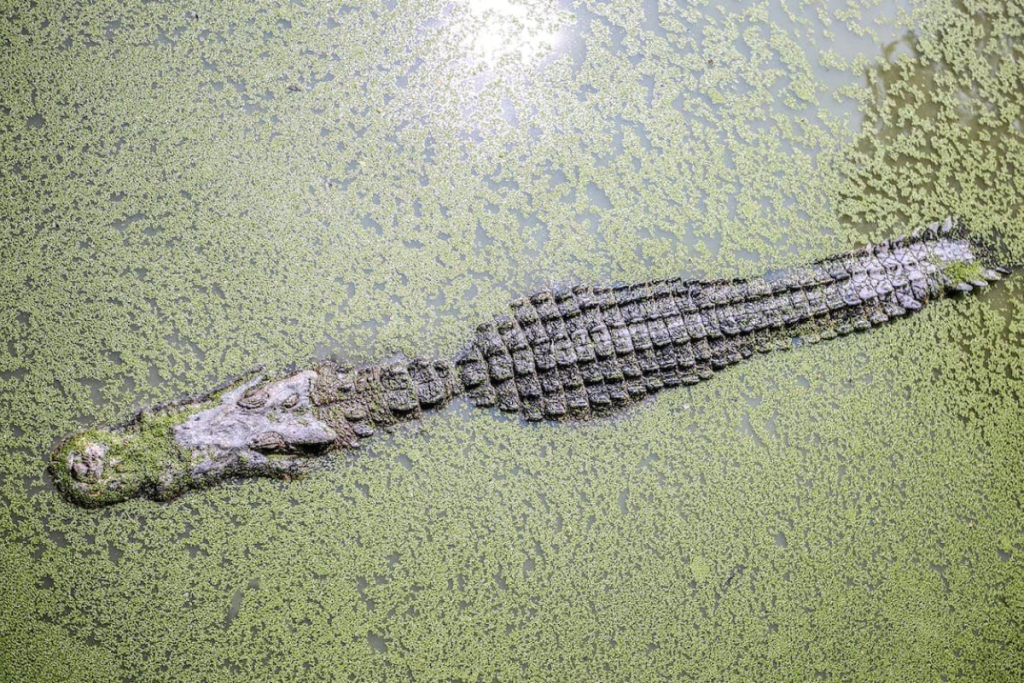
Key Takeaways Alligators have long fascinated us with their prehistoric appearance and enigmatic behaviors, particularly when it comes to their survival strategies in the diverse ecosystems they inhabit. This comprehensive guide delves into the heart of swamp environments to uncover the truth behind alligator hibernation, exploring their biological rhythms, seasonal behaviors, and interactions within their habitats. As we navigate through the intricacies of alligator life, we uncover the myths and realities that surround these formidable swamp creatures. Understanding Alligator Dormancy As temperatures drop in the winter months, alligators enter a state of dormancy that is often likened to hibernation. However, this period of inactivity, scientifically referred to as brumation, is distinct from the true hibernation observed in mammals. During brumation, alligators slow their metabolism and become less active, but they do not sleep continuously. Alligators have adapted to their environments by developing a unique response to cold weather. Unlike true hibernators, alligators can still move around, albeit sluggishly, and will occasionally emerge for sunning if the weather permits. Alligators’ dormancy is influenced by their habitat and the climate. In regions where the winter is milder, such as Louisiana’s swamps, alligators may be active year-round. Here’s a brief overview of alligator activity: The Impact of Seasonal Changes on Alligator Behavior Alligators are remarkable creatures that have adapted to thrive in various environmental conditions. Seasonal changes, particularly temperature fluctuations, play a significant role in dictating alligator behavior. During warmer months, alligators are highly active, engaging in feeding, mating, and territory establishment. However, as temperatures drop, their activity levels decrease substantially. Alligators do not truly hibernate but enter a state of torpor during colder months. This period of reduced metabolic activity allows them to conserve energy when food is scarce and temperatures are low. Understanding the nuances of alligator behavior in response to seasonal changes is crucial for their conservation. As the climate shifts, the survival of alligators may depend on their ability to adapt to more extreme conditions. Conservation efforts must consider these behavioral patterns to ensure the protection of alligator populations in their natural habitats. Myths and Misconceptions About Alligator Hibernation One of the most common misconceptions about alligators is that they hibernate during the colder months. Alligators do not hibernate; instead, they enter a state of dormancy known as brumation. Unlike hibernation, which is a deep sleep, brumation is a period of reduced activity but not complete inactivity. During brumation, alligators will often seek shelter in burrows or dens, which can be located in a variety of places such as below roads or at the edges of lakes. These refuges provide protection from the cold and allow alligators to conserve energy. Alligators’ response to cold weather is often misunderstood. They slow down and limit their activity, but they remain alert and capable of movement if necessary. While it’s true that alligators’ metabolism slows down as temperatures drop, they still need to surface for air and can move about if the weather warms up. This adaptive behavior ensures their survival during less favorable conditions. The Biological Clock of Alligators Physiological Adaptations for Survival Alligators are remarkable creatures with a suite of adaptations that enable them to thrive in their swampy habitats. Their skin is fortified with osteoderms, strong bony plates that provide protection and aid in thermoregulation. Below the surface, their physiology is fine-tuned for survival. These features are not just for survival, but also for maintaining their status as apex predators. Alligators’ adaptations are a testament to their evolutionary success, allowing them to persist in environments that would be challenging for less equipped species. Alligators exhibit a remarkable ability to regulate their body temperature through behavioral means, often basking in the sun to warm up or retreating to the water to cool down. This behavioral thermoregulation is crucial for their survival and daily activities. Temperature Regulation and Metabolic Changes Alligators have evolved to thrive in the swamp’s fluctuating temperatures through a remarkable ability to regulate their body heat and metabolism. This metabolic adjustment is crucial for survival, as it allows alligators to endure periods of cold without the need for constant food intake. When temperatures drop, alligators often retreat to mud holes or underwater burrows, which provide insulation from the cold. These refuges are essential for their survival during the winter months. Alligators’ ability to regulate their body temperature and metabolism is a key adaptation that enables them to dominate the swamp ecosystem. Understanding these physiological changes is vital for conservation efforts, as it helps predict how alligators might respond to environmental stressors such as climate change. By studying their temperature regulation and metabolic rates, researchers can better protect these ancient reptiles. The Role of Brumation in Alligator Life Cycles Brumation is a critical survival mechanism for alligators, particularly in regions where winter temperatures can plummet. During brumation, alligators slow down their metabolism significantly, which allows them to conserve energy when food is scarce and temperatures are too low for normal activity. This state is not a deep sleep like hibernation, but rather a period of reduced activity where alligators can still move, albeit sluggishly. Alligators have adapted to their environments by developing this unique form of dormancy. It enables them to withstand cold conditions that would otherwise be detrimental to their survival. While in brumation, alligators will often stay submerged in water or mud, with their snouts above the surface to breathe. This behavior has been observed even in extreme conditions, such as when the surface of the water freezes over. Alligator Activity Patterns Throughout the Year Summer: The Peak of Alligator Activity During the summer months, alligators are at their most active, engaging in behaviors crucial for their survival and reproduction. This period coincides with the alligator mating season, typically spanning from April to June, when male alligators are particularly on the prowl for potential mates. Alligators’ heightened activity in summer is not only about reproduction but also involves increased hunting and territorial defense. The following table outlines the typical daily activity patterns of alligators in the
What’s the Chilling Secret of Alligators in Winter?
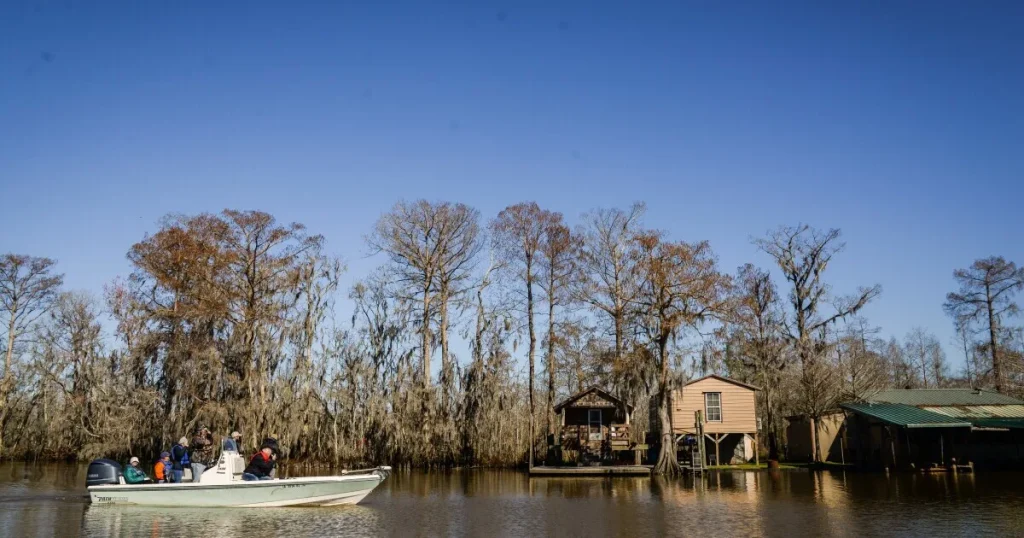
What’s the Chilling Secret of Alligators in Winter? What do they do? Alligators are fascinating creatures, particularly when it comes to their survival strategies during the winter months. As cold-blooded animals, they must find ways to cope with the drop in temperatures. This article dives into the world of alligators in winter, exploring their behaviors, habitats, and physiological adaptations that enable them to endure the colder weather. We’ll look at how alligators brumate, the conditions of their winter dens, and the extent of their resilience in freezing conditions, including their surprising ability to survive in some northern climates. Understanding Alligator Brumation The Basics of Brumation Brumation in alligators is a period of dormancy that occurs during the colder months. Alligators, like other reptiles, enter this state to conserve energy when temperatures drop and food becomes scarce. Unlike hibernation in mammals, which involves deep sleep, brumation is characterized by a significant slowdown in metabolism but not complete inactivity. During this time, alligators may seek shelter in burrows or underwater dens, where they can remain for extended periods without the need for frequent feeding. This adaptation is essential for their survival in varying climates, particularly in areas where winter conditions can be harsh. Alligators’ ability to brumate allows them to endure periods of cold that would otherwise be lethal to a cold-blooded species. The duration of brumation can vary greatly, from a few hours to several months, depending on the severity of the weather and the specific needs of the animal. It is a crucial strategy for alligators to manage their energy reserves and maintain their physiological functions at minimal levels until the environment becomes more hospitable. How Alligators Prepare for Dormancy As the chill of winter approaches, alligators engage in a fascinating preparation for dormancy known as brumation. They seek out and create dens in the banks of ponds or rivers, providing a sheltered environment to endure the cold. These dens, often referred to as ‘gator holes,’ are dug out using their powerful claws and snouts, and can be quite elaborate, sometimes extending several meters inland. During this period, alligators exhibit a remarkable reduction in their metabolic activity. They cease feeding as temperatures drop below 70 degrees Fahrenheit, conserving their energy for the duration of the colder months. The alligators’ ability to survive even freezing conditions is a testament to their resilience and adaptability. Alligators are considered relatively cold-tolerant, demonstrating the capacity to survive extended periods of sub-freezing temperatures by entering a state of brumation. While in brumation, alligators may remain motionless for long periods, often with only their snouts protruding from the water’s surface. This behavior allows them to breathe while the rest of their body is protected from the cold, ensuring their survival through the winter season. Surviving Freezing Conditions Alligators have a remarkable ability to withstand cold temperatures that would be lethal to many other creatures. Alligators can survive in water as cold as 40F by entering a state of brumation, a dormancy-like state akin to hibernation in mammals. During this period, they become lethargic and their metabolic rates drop significantly, allowing them to conserve energy. Alligators demonstrate an extraordinary adaptation to freezing conditions by allowing themselves to freeze in place with their snouts above the water. This behavior ensures they can breathe and survive even when the water’s surface freezes over. While alligators are considered relatively cold-tolerant, their survival in freezing conditions is not without limits. The following points outline the critical factors for their survival: Alligator Winter Behavior and Habitat Alligator Activity Below 70 Degrees Fahrenheit As temperatures drop below the 70-degree mark, alligator behavior undergoes a significant shift. Alligators require warmer temperatures to digest their food effectively, and as such, their feeding habits are greatly reduced in cooler weather. During this time, they may be seen basking in the sun to absorb heat, but their overall activity levels are diminished. Alligators are surprisingly resilient to cold temperatures, capable of surviving even when the mercury dips below 40 degrees Fahrenheit. However, their survival strategy involves becoming lethargic and minimizing energy expenditure. This adaptation is crucial for enduring the winter months when their metabolic rate is also lowered to conserve energy. Alligators have survived millions of years but need temperatures above 40 degrees to be active. Despite their resilience, alligators are not truly active in colder conditions. They rely on external heat sources to regulate their body temperature, and without sufficient warmth, they enter a state of dormancy until the environment becomes favorable again. Denning: Alligators’ Winter Refuge As temperatures drop, alligators actively seek out dens to serve as their winter refuge. These dens, often burrowed into the banks of ponds or rivers, are crucial for the survival of many animals during the colder months. Alligators are known to be relatively cold-tolerant, and their ability to survive freezing conditions is a testament to their resilience. They may remain dormant in these dens, emerging only when the weather warms. Alligators’ dens are not just simple burrows; they can be quite complex and may have multiple chambers. These dens are utilized year-round but are especially important from October to March when alligators enter a state of brumation. While alligators are ectothermic, relying on external sources to regulate their body temperature, they have adapted behaviors to cope with cold weather. By lowering their metabolic rates and becoming lethargic, they can conserve energy and survive periods of cold that would otherwise be lethal. Geographical Limits of Alligator Habitats in Winter The geographical range of alligators in winter is a testament to their adaptability, but it has clear boundaries. American alligators are primarily found in the southeastern United States, with their habitat extending as far north as North Carolina and as far west as eastern Texas. Their presence in southern Florida, including the Everglades, marks the southernmost extent of their range. During the colder months, alligator sightings are less frequent, but not unheard of, even in the chill of January. This indicates that while alligators are less active, they are still
